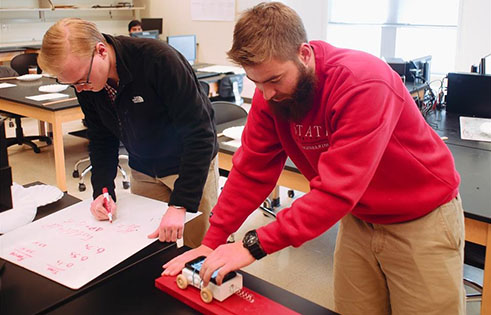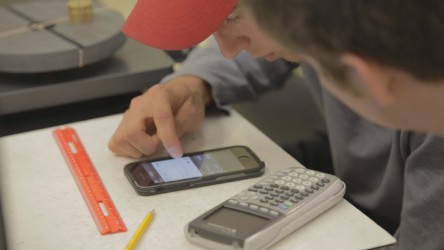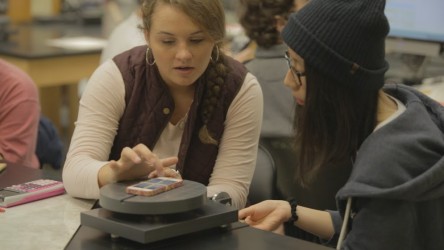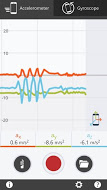MyTech: Taking Physics Beyond the Classroom

“There’s an app for that!” has been said time and time again. Now, after teaming with DELTA staff and receiving a DELTA Exploratory Grant, Dr. Colleen Countryman has brought this quote to life. MyTech, a free app available on Google Play and in the Apple App Store, allows students to test and apply their physics knowledge inside the classroom and in everyday environments.
Countryman, a teaching assistant professor of Physics 205 and 208, witnessed the technology utilized in physics labs at NC State and the struggles students had with it.
“This study was primarily motivated by the operational and attitudinal difficulties encountered by students when they use traditional ‘black box’ interfaces in their labs,” stated Countryman. However, the same data collected in the labs using this traditional black box technology can be obtained by the sensors within a smartphone device. Recognizing this difficulty and unfamiliarity with the traditional technology gave Countryman the idea to create an easy-to-use app to assist her students’ understanding of physics concepts.

Prior to receiving her grant in 2014-15, Countryman approached DELTA with her idea for improving physics labs through the use of smartphones. She had been gathering promising data on her own two years prior to this endeavor as part of her dissertation on using smartphones in physics labs. In order to collect information, she used previously developed physics apps and tested them against a control group. She included the student feedback in her proposal for an exploratory grant which was accepted in July 2014.
Once the grant was accepted, the project team was assembled.
While Countryman and Professor of Physics Dr. Michael Paesler served as the subject matter experts and physics education researchers, DELTA staff members David Tredwell and Yan Shen spearheaded the team that brought the project to life.
Tredwell, a multimedia specialist who served as project lead, was in charge of facilitating the team and its efforts. He ensured everyone had the necessary resources for the project to come together. He is also credited as the app developer. Yan Shen was the instructional designer for the application. Shen worked closely with Countryman to develop instructional goals and objectives, decide what students should learn from the app and what learning challenges should be addressed. Countryman and Shen were also tasked with creating solutions and evaluating focus groups and student interviews.
 Other DELTA staff members involved in the project were Samantha McCuen, Laurie Gyalog, Chrissie Van Hoever and Kelly Fish. McCuen and Gyalog served as project coordinators while Van Hoever and Fish were the project’s visual designers.
Other DELTA staff members involved in the project were Samantha McCuen, Laurie Gyalog, Chrissie Van Hoever and Kelly Fish. McCuen and Gyalog served as project coordinators while Van Hoever and Fish were the project’s visual designers.

As coined by Tredwell, this “hyper-focused” group with “good vision” was continuously encouraged by Countryman. She knew the transition from the standard laboratory technology to smartphones was a good idea because of her observations and experiences in the classroom. While students are unfamiliar with black boxes, they are rarely separated from their smartphones. Presenting her experiences to the team and pairing it with prior knowledge about the features and appearances of already available apps, the group decided simpler was best.
“There are other apps that do similar things as [MyTech], but not many are as well designed as this one. MyTech is specifically designed to not overload students and to be apparent about what it is doing,” said Tredwell. “Our goal was to create something user-friendly.”
What exactly is it doing?
MyTech allows individuals to analyze the motion of their handheld device by using raw data from the phone’s internal sensors as it undergoes motion on carts, pendulums and with springs. Live data is constantly recorded from the accelerometer and gyroscope within the phone and is presented on a continuously scrolling graph. When a different force acts on the device, the lines on the graph will move accordingly in real-time.
Users can also reduce the cognitive load by fading lines if they are attempting to focus on just one axis or direction.By providing this resource to students through cell phone applications, they are able to see how physics is applied outside of the lab.
Although still undergoing evaluation, Tredwell has high hopes for the inclusion of the app in the classroom and physics lab.
“There’s something appealing about having phones being more useful in the classroom,” Tredwell said. “It would be great if we could shift the mindset from ‘Everybody, don’t use your phones’ to using them to participate. There are benefits of having all this power in your fingertips.”


